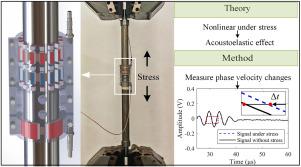用电磁声换能器测量管道应力
IF 9.4
1区 工程技术
Q1 ENGINEERING, MECHANICAL
International Journal of Mechanical Sciences
Pub Date : 2025-09-29
DOI:10.1016/j.ijmecsci.2025.110889
引用次数: 0
摘要
应力集中是飞机致动器和船舶金属管道系统失效的主要原因之一。传统的应变仪只能测量结合点处的应力,而x射线设备由于辐射大,体积大,不适合现场测量。为了开发一种适用于管道现场应力测量的新方法,研究了金属管道对导波速的非线性影响,并尝试建立导波速与应力之间的关系,通过测波速反演管道内应力状态。理论分析评估了特定导波模式对应力的敏感性,设计了一种新型电磁声换能器。采用自适应信任域贝叶斯优化(ATRBO)算法对其结构进行优化,选择性地激发特定模式。实验表明,该方法最大测量误差为8.8 MPa,可完成空间分辨率为100 mm的管道应力扫描任务。这代表了一种不需要耦合的应力扫描新方法,特别适用于密集作业管道中的非接触式现场测量。本文章由计算机程序翻译,如有差异,请以英文原文为准。

Stress measurement in pipelines using electromagnetic acoustic transducers
Stress concentration is one of the main causes of failures in aircraft actuators and metal piping systems in ships. Traditional strain gauges can only measure stress at the bonding points, while X-ray equipment, being radiative and bulky, is unsuitable for on-site measurements. To develop a new method suitable for on-site stress measurement in pipelines, the nonlinear effects of metal pipes on guided wave velocity were investigated, and an attempt was made to establish a correlation between wave velocity and stress, enabling the back-calculation of the stress state in the pipeline through wave velocity measurements. The theoretical analysis assessed the sensitivity of specific guided wave modes to stress, and a novel electromagnetic acoustic transducer (EMAT) was designed. Its structure was optimized using the adaptive trust region Bayesian optimization (ATRBO) algorithm to selectively excite specific modes. Experiments demonstrated that this method achieves a maximum measurement error of 8.8 MPa and can complete pipeline stress scanning tasks with a spatial resolution of 100 mm. This represents a new method for stress scanning that does not require coupling, making it particularly suitable for non-contact on-site measurements in dense operational pipelines.
求助全文
通过发布文献求助,成功后即可免费获取论文全文。
去求助
来源期刊

International Journal of Mechanical Sciences
工程技术-工程:机械
CiteScore
12.80
自引率
17.80%
发文量
769
审稿时长
19 days
期刊介绍:
The International Journal of Mechanical Sciences (IJMS) serves as a global platform for the publication and dissemination of original research that contributes to a deeper scientific understanding of the fundamental disciplines within mechanical, civil, and material engineering.
The primary focus of IJMS is to showcase innovative and ground-breaking work that utilizes analytical and computational modeling techniques, such as Finite Element Method (FEM), Boundary Element Method (BEM), and mesh-free methods, among others. These modeling methods are applied to diverse fields including rigid-body mechanics (e.g., dynamics, vibration, stability), structural mechanics, metal forming, advanced materials (e.g., metals, composites, cellular, smart) behavior and applications, impact mechanics, strain localization, and other nonlinear effects (e.g., large deflections, plasticity, fracture).
Additionally, IJMS covers the realms of fluid mechanics (both external and internal flows), tribology, thermodynamics, and materials processing. These subjects collectively form the core of the journal's content.
In summary, IJMS provides a prestigious platform for researchers to present their original contributions, shedding light on analytical and computational modeling methods in various areas of mechanical engineering, as well as exploring the behavior and application of advanced materials, fluid mechanics, thermodynamics, and materials processing.
 求助内容:
求助内容: 应助结果提醒方式:
应助结果提醒方式:


